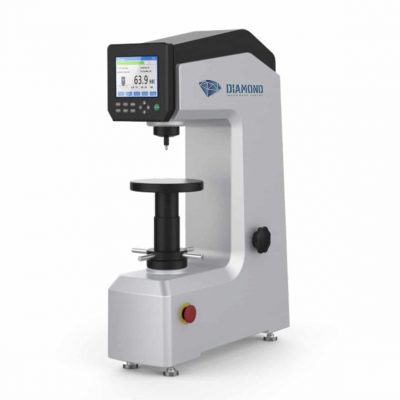Home > Micro Vickers Hardness Tester
Superficial Hardness Tester
Products
For materials that are thin and sensitive to load application, a type of Rockwell hardness test called the superficial hardness test is conducted. The Superficial hardness tester includes an indenter made from a diamond cone or a hardened steel ball of four different diameters. Also, the combination of the load is in three steps of 15kgf, giving a total of 15 different scales. To carry out the superficial test, a minor load impacts the material’s surface with a 3kgf, and once it has steadied itself, a major load of either 12kg, 27kgf, or 42kgf is applied. The major load is removed after steadying it for a while, and the depth of the impression on the material surface is taken. This depth is plugged into a formula that helps calculate the material’s hardness value.
Superficial Hardness Tester
Why Global Clients Choose Us?
25 Years of Expertise
We have 25 years of experience in the professional production of hardness testing devices, an annual output of more than 10,000 hardness testers.
Talented Engineers and support team
As of September 2020, we have a total of 125 employees, including nearly 35 professional and technical workers who are masters or doctorate degree holders.
Advanced production equipment
We have Complete machining workshop, CNC, CNC machine tools, and more than 50 other types of processing equipment,to ensure high-precision product parts.
Excellent After-Sales Service
We provided excellent after-sales service, including fast delivery, online training, immediate feedback of trouble shotting.
Questions on Superficial Hardness Tester
1. Features and Advantages of Superficial Hardness Tester
The features and advantages of the superficial hardness test include:
- It provides more accuracy for measuring the hardness of thin and load-sensitive materials
- It has specific indenter types for different materials. Diamond indenters for hard materials and ball indenters for thin materials.
- It accommodates the testing of boat ferrous and non-ferrous material, including ceramics and coatings.
- It is very fast and precise
- It conforms to known standards of ASTM and ISO
- It features several load options and indenter sizes.
2. What is the Difference between Rockwell Test and Superficial Rockwell Test?
While the superficial Rockwell and Rockwell tests have several similarities, they are not without their differences. One significant difference is their application, as the Rockwell test is often applied to thick materials while the superficial Rockwell test is most suitable for thin and load-sensitive materials. Also, the applied force is quite different. Where the minor loads for the Rockwell test are 10kgf, the superficial Rockwell test applies 3kgf for the minor loads. Similarly, their major loads differ significantly, with the Rockwell test applying between 60 to 150kgf while the superficial test applies between 15 to 45kgf as major loads. They are also designated differently as their load combination and indenter types give different scales, including HRN, HRT, HRW, HRX, and HRY for superficial, while HRB, HRC, HRM, and HRR are for standard Rockwell test.
3. Test Standards
The superficial Rockwell hardness testing conforms to related industry-specific and international standards. For instance, the ASTM E18 is the applicable standard for testing metals related to the ISO 6508, also used for carrying superficial Rockwell testing for metals. Likewise, the ASTM D785 is the applicable standard with necessary procedures for carrying out superficial hardness testing for plastics, with a similar procedure found in ISO 2039.
Related Article: ASTM Rockwell Hardness Standard Test Reference Guide
Related Article: ASTM Vickers Hardness Standard Test Reference Guide
4. Superficial Rockwell Hardness Tester Scale/ Indenter/ Load Chart
Scale Symbol | Indenter Type | Preliminary Force N (kgf) | Total Force N (kgf) | Similar to A, C, and D scales but for thinner gage material Typical Applications |
15N | Sphero-conical Diamond | 29.42 (3) | 147.1 (15) | |
30N | Sphero-conical Diamond | 29.42 (3) | 294.2 (30) | |
45N | Sphero-conical Diamond | 29.42 (3) | 441.3 (45) | |
15T | 1/16” Carbide Ball | 29.42 (3) | 147.1 (15) | Similar to B, F, and G scales but for thinner gage material. |
30T | 1/16” Carbide Ball | 29.42 (3) | 294.2 (30) | |
45T | 1/16” Carbide Ball | 29.42 (3) | 441.3 (45) | |
15W | 1/8” Carbide Ball | 29.42 (3) | 147.1 (15) | Very Soft Material |
30W | 1/8” Carbide Ball | 29.42 (3) | 294.2 (30) | |
45W | 1/8” Carbide Ball | 29.42 (3) | 441.3 (45) | |
15X | ¼” Carbide Ball | 29.42 (3) | 147.1 (15) | |
30X | ¼” Carbide Ball | 29.42 (3) | 294.2 (30) | |
45X | ¼” Carbide Ball | 29.42 (3) | 441.3 (45) | |
15Y | ½” Carbide Ball | 29.42 (3) | 147.1 (15) | |
30Y | ½” Carbide Ball | 29.42 (3) | 294.2 (30) |
In conclusion, the superficial Rockwell hardness testing is suitable for accurately measuring load-sensitive and thin materials’ hardness. Though similar in some ways to the standard Rockwell hardness testing, its application, load range, indenter type, and sizes and hardness value designations are very different. Hence it is important to understand the workings, procedures, and applicable standards for superficial hardness testing to take full advantage of this test method.









